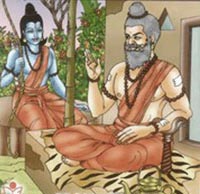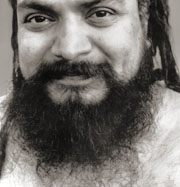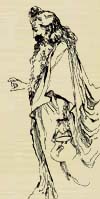The Yoga Vasishta Maharamayana
“Read the Yoga Vasishta,” Swamiji said. “Swamiji’s philosophy is fully expounded in that scripture.” He explained that it is the only book that accurately preserves a yogi’s teachings. Other scriptures, he often said, have been altered over time.
Yoga Vasishta Ramayana is the record of Sage Vasishta teaching the young Lord Rama about the true nature of existence. Rama is an incarnation of Vishnu, God the Sustainer. Vasishta is a yogi, an ancient muni. Over the course of twenty-two days, Rama asks questions and Vasishta answers, lectures, and tells stories. Through the process, Rama comes to realize his own true nature and attains Self-realization. All this takes place before the assembled court of Rama’s father, King Dasharata, and numerous sages, gods, nobles and brahmin priests.
Yoga Vasishta is considered among the most valuable spiritual treatises and the most comprehensive exposition of non-dualistic (advaita) philosophy or Vedanta.
Yoga Vasishta is an extraordinarily long book. It consists of 32,000 slokas (couplets, verses of two lines each), mostly spoken by Sage Vasishta. By comparison, Krishna spoke only 18 slokas on the occasion that has become memorialized in the Bhagavad Gita. The only unabridged English translation of Yoga Vasishta, the 1891 publication of V. L. Mitra, runs almost a million words, about a third longer than the entire King James Bible.
Swamiji said that everything that humanity needs to know and everything a person could possibly want to know is in Yoga Vasishta, and that it contains everything from politics to gambling to knowing how to deceive. There is no need to read any other book. Swamiji advised that we should not try to read it all. Instead, we should focus on a subject area in which we are interested. Swamiji said that he had read the entire book three times, in both Sanskrit and Telugu, and that he understood it all.
A devotee once asked whether Swamiji had any special connection with Yoga Vasishta because he referred to it so often. Swamiji responded, "Meditate and you will know the answer." He added that he was present when the events described in the book took place. Rama was only eight years old at the time, explained Swamiji — a detail at variance with the text that describes Rama as a young teenager. Swamiji often corrected scriptural details, which made his listeners suspect that he had been an eyewitness to ancient events. Listening to Shivabalayogi talk about Yoga Vasishta, many devotees came to the conclusion that he was Vasishta. All Shivabalayogi admitted was to being there when Vasishta taught Rama.
Ramana Maharshi, another great yogi of the 20th century, often cited Yoga Vasishta. Ramana encouraged the practice of self-inquiry and one who reads Yoga Vasishta will find it to be the quintessential treatise on the practice.
 The book is attributed to Sage Valmiki, the same person who
wrote the epic history of Rama, the Ramayana, which events take place
in the life of Rama after those in Yoga Vasishta.
The book is attributed to Sage Valmiki, the same person who
wrote the epic history of Rama, the Ramayana, which events take place
in the life of Rama after those in Yoga Vasishta.
The essence of the philosophy in Yoga Vasishta is that only consciousness exists. There is no "material" substance, only the idea of it. God is consciousness. Creation is not a separate existence from God but an aspect of God. Each individual is consciousness, ultimately the same indivisible Divine Consciousness, and not any physical body.
![]()
The only complete English translation of Yoga Vasishta Maharamayana is by Vihari Lal Mitra, published in 1891. It is a monumental work in two volumes, long since out of print. Copies are difficult to find although the 1891 translation is available in digital form through Project Gutenberg..
The complete, unabridged Yoga Vasishta Ramayana, an updated version of V.L. Mitra's 1981 translation, is a free download as an ebook at the Yoga Vasishta page in the Bookstore. It is also available for purchase in hardcover book form.
![]()
This is the Yoga Vasishta HOME page │ NEXT page

